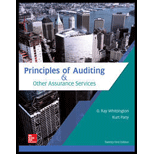
Principles Of Auditing & Other Assurance Services
21st Edition
ISBN: 9781259916984
Author: WHITTINGTON, Ray, Pany, Kurt
Publisher: Mcgraw-hill Education,
expand_more
expand_more
format_list_bulleted
Question
Chapter 9, Problem 37GOQ
To determine
Identify the appropriate answer related to the type of sampling used in the test of control.
Expert Solution & Answer
Want to see the full answer?
Check out a sample textbook solution
Students have asked these similar questions
Which of the following pairs of selection methods could appropriately be used in statistical sampling applications?a. Unrestricted random selection, block selection.b. Block selection, haphazard selection.c. Systematic random selection, haphazard selection.d. Unrestricted random selection, systematic random selection.
A principal advantage of statistical methods of attribute sampling over nonstatistical methods is that they provide a scientific basis for planning the
A. risk of overreliance
B. tolerable rate
C. expected population deviation rate
D. Sample size
How does Probability Proportionate to Size (PPS) sampling compare to Classic Variables sampling?
Chapter 9 Solutions
Principles Of Auditing & Other Assurance Services
Ch. 9 - Prob. 1RQCh. 9 - Prob. 2RQCh. 9 - Prob. 3RQCh. 9 - Prob. 4RQCh. 9 - Prob. 5RQCh. 9 - Prob. 6RQCh. 9 - Prob. 7RQCh. 9 - Prob. 8RQCh. 9 - Prob. 9RQCh. 9 - Prob. 10RQ
Ch. 9 - Prob. 11RQCh. 9 - Prob. 12RQCh. 9 - What is a dual-purpose test?Ch. 9 - Prob. 14RQCh. 9 - Prob. 15RQCh. 9 - Prob. 16RQCh. 9 - What would be the difference between an attributes...Ch. 9 - Prob. 18RQCh. 9 - Prob. 19RQCh. 9 - Prob. 20RQCh. 9 - Prob. 21RQCh. 9 - Prob. 22RQCh. 9 - Prob. 23RQCh. 9 - Prob. 24RQCh. 9 - Prob. 25RQCh. 9 - Prob. 26RQCh. 9 - Prob. 27RQCh. 9 - Prob. 28RQCh. 9 - Prob. 29QRACh. 9 - Prob. 30QRACh. 9 - Prob. 31QRACh. 9 - Prob. 32QRACh. 9 - Prob. 33QRACh. 9 - Prob. 34QRACh. 9 - Prob. 35QRACh. 9 - Prob. 36QRACh. 9 - Prob. 37AOQCh. 9 - Prob. 37BOQCh. 9 - Prob. 37COQCh. 9 - Prob. 37DOQCh. 9 - Prob. 37EOQCh. 9 - Prob. 37FOQCh. 9 - Prob. 37GOQCh. 9 - Prob. 37HOQCh. 9 - Prob. 37IOQCh. 9 - Prob. 37JOQCh. 9 - Prob. 37KOQCh. 9 - Prob. 37LOQCh. 9 - Prob. 38OQCh. 9 - Prob. 39OQCh. 9 - For each term in the first column below, identify...Ch. 9 - Prob. 41OQCh. 9 - Smith, Inc. Rachel Robertson wishes to use...Ch. 9 - Prob. 43OQCh. 9 - Prob. 44PCh. 9 - Prob. 45PCh. 9 - Prob. 46PCh. 9 - Prob. 47PCh. 9 - In the audit of Potomac Mills, the auditors wish...Ch. 9 - Prob. 49PCh. 9 - Prob. 50PCh. 9 - Prob. 51PCh. 9 - Prob. 52ITC
Knowledge Booster
Similar questions
- Understand how to use sequential sampling,discovery sampling, and nonstatisticalsampling in attributes testing.arrow_forwardWhat type of sampling are Control Tests?arrow_forwardIdentify the Sampling technique shown in .this picture (ihä 1) Simple Random Sampling O Systematic Random Sampling O Stratified Random Sampling O Cluster Sampling Oarrow_forward
- A type of sampling application in which a relatively small initial sample is examined anddecisions regarding expanding that sample are based on the results of this initial sample isknown asa. Attributes sampling.b. Discovery sampling.c. Sequential sampling.d. Statistical sampling.arrow_forwardWhat is the formula for Audit Sampling?arrow_forwardAn advantage of statistical sampling over nonstatistical sampling methods is that statistical methodsa. Afford more assurance than a nonstatistical sample of equal size.b. Provide an objective basis for quantitatively evaluating sampling risk.c. Can more easily convert the sample into a dual-purpose test useful for substantive procedures.d. Eliminate the need to use judgment in determining appropriate sample sizesarrow_forward
arrow_back_ios
arrow_forward_ios
Recommended textbooks for you
 Auditing: A Risk Based-Approach (MindTap Course L...AccountingISBN:9781337619455Author:Karla M Johnstone, Audrey A. Gramling, Larry E. RittenbergPublisher:Cengage Learning
Auditing: A Risk Based-Approach (MindTap Course L...AccountingISBN:9781337619455Author:Karla M Johnstone, Audrey A. Gramling, Larry E. RittenbergPublisher:Cengage Learning

Auditing: A Risk Based-Approach (MindTap Course L...
Accounting
ISBN:9781337619455
Author:Karla M Johnstone, Audrey A. Gramling, Larry E. Rittenberg
Publisher:Cengage Learning